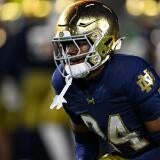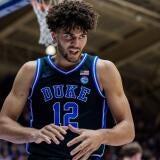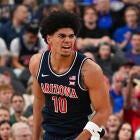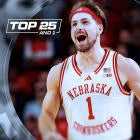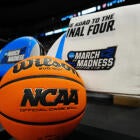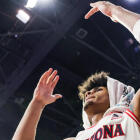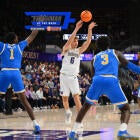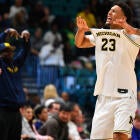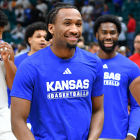Houston coach Kelvin Sampson is winning after his career was derailed for NCAA violations that are now allowed
Imagine what Sampson might have already accomplished if he hadn't broke NCAA rules that seem trivial in NIL era
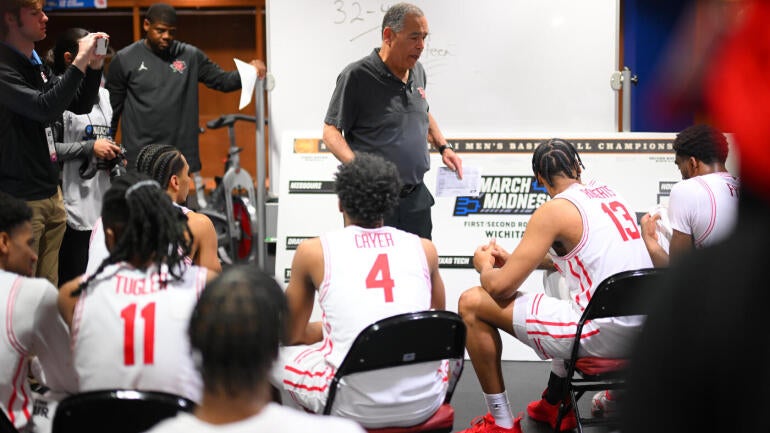
The case has faded from view for Tom Yeager. But back in 2006 the former Colonial Athletic Association commissioner presided over one of the bigger NCAA infractions cases of the decade.
Then Oklahoma coach Kelvin Sampson (and his staff) were accused of making hundreds of phone calls to prospects against NCAA rules. All of it was distilled to a series of major violations. Not only that, but Sampson did the same thing after he moved on to Indiana. He and that school were sanctioned as well in 2008.
A five-year show cause order applied by the NCAA essentially rendered Sampson unhirable in the college space. He spent six years in the NBA as an assistant before getting back to college with Houston in 2014.
You should be familiar with what has happened since. Once a pariah, Sampson led the Cougars back to becoming a national power. They're currently in their sixth consecutive Sweet 16 this week playing Purdue Friday night in a Midwest Region semifinal in Indianapolis.
Time heals all infractions, it seems. The transgressions that altered Sampson's career and life are so distant they seem almost laughable now. In an age when NIL marketing agents run amok and the going rate for top football and basketball prospects is $1 million, wrongdoing not only has been redefined, the concept has almost been eliminated.
"I had dinner with Dave Berst," Yeager said, referring to the former all-powerful NCAA enforcement chief. "We were joking. What in the heck is against the rules now?"
Not much. But back in 2006 Yeager sat in judgment over Sampson and Oklahoma as chairman of the NCAA Committee on Infractions in that Oklahoma case.
"It was a hearing where kind of the behavior escalated it more than the actual violations …," Yeager said. "I have a real vague recollection. It was kind of argumentative. I won't say fighting. He left right in the middle of the case [for the Indiana job], right before it was coming to the hearing. So it was kind of a get out of town ahead of the posse showing up.
"It wasn't on the top 10 most egregious list by any stretch."
But those were the days when – the saying goes – the NCAA could convict a ham sandwich if it desired. Not so now. With the Power Four set to assemble its own investigative staff in the House settlement, there may not be much left for the NCAA to investigate.
"I get disappointed when I see a couple of the cases that have come out that sound like escalated parking tickets," Yeager added. "I'm well aware that escalated parking tickets can be a problem. But sooner or later you'd like to see some felons convicted. If there are any more. It may be tough to become a felon."
But this is not so much a NCAA rehash, but about a (career) remake. This is also about a ladder. Sampson still has it. Oklahoma AD Joe Castiglione sent it as a gift when Sampson got that Houston job in 2014. The same Joe C who watched the OU hoops program get slapped after Sampson's transgressions.
The same Castiglione who is rooting just as hard as any Houston fan this week.
"I just believed in him. We had such a great working relationship," Castiglione said. "He had done a wonderful job at Oklahoma."
After the NBA, Sampson started over at Houston. When he arrived the program hadn't won an NCAA Tournament game since the Phi Slama Jama days in 1984. It took him until Year 4 at Houston to finally break a 33-year tournament drought
The ladder was both symbolic and practical. Ladders are used to cut down nets following championships. Castiglione's congratulatory note that went with the gift read, "I hope you'll need to use this a lot during your journey as a Houston Cougar."
The ladder has been broken out to cut down nets each time Houston clinches a regular-season championship. That has happened eight times since Sampson arrived. (Either after clinching at home, or the next home game after clinching on the road.)
Nineteen years after the fact, the lens through which to judge/remember Sampson has refocused. How many of us are at the peak of our careers at age 69? How many of us are among the most beloved figures in our profession? Sampson is both.
"There's a lot to explain," Castiglione said. "There really wasn't animosity. Obviously we were very disappointed having gone through that and we self-imposed our own penalties. After the infractions committee there were a few more [penalties]. No one wants to have that happen.
"It wasn't like we were dismissing the disappointment. [But Sampson] was totally forthcoming.. Even the NCAA investigative staff were remarking on how much cooperation there was.
"For whatever season he thought he was outworking his competition."
Besides, we live in an age when coaches' images get remade like multi-million dollar Play-Doh.
Under Rick Pitino, Louisville became the first men's basketball program to have a national championship vacated. Now he is the toast of New York with St. John's.
Disgraced former Baylor coach Dave Bliss has had four combined pro, high school and college jobs since resigning amid a player's murder and NCAA scandal.
Chris Beard is leading Ole Miss into the Sweet 16 after being fired at Texas in 2023.
Sampson's misdeeds were nowhere similar to the issues for those coaches. An allegation that he misled NCAA investigators at Indiana was denied by the coach.
"There wasn't anything else," Castiglione said. "There were phone calls."
For 12 years Sampson and Castiglione were a powerful partnership. Sampson took OU – a football school – to 11 NCAA Tournaments and the 2002 Final Four. Four years later the partnership was over. Sampson resigned at Oklahoma.
The ban on cell phone contact was so ludicrous that the NCAA eventually changed the rules. What Sampson did is now legal. Coaches can make unlimited calls and texts to recruits following a prospect's high school sophomore year.
"Everything he did was [eventually] allowed …," former Houston AD Mack Rhoades, now at Baylor, told CBS Sports back then. "Yes, those rules are no longer applicable but rules are rules."
"It's important to consider the context of the Oklahoma and IU phone call violation cases …," said Josh Lens, head of The Compliance Group, a firm that shepherds schools through NCAA compliance reviews and audits. "The recruiting phone call rules at the time were very technical and complicated. On top of that, the NCAA and Committee on Infractions expected coaches to document their recruiting calls … The recruiting phone call rules have changed considerably since [then]. Coaches have more freedom to make calls today."
From two NCAA cases, a case can be made -- that Sampson's excellence lifted Houston the final step into the Big 12 a couple of years ago. Certainly, Houston was valued as a market, a recruiting territory and for its football potential. But the potential to have both programs humming at a Power Five level was important.
"He built that program when it was from the ashes," Castiglione said of Sampson. "It's beyond impressive."
And it's not over. That six-year Sweet 16 run leads the nation. For a third straight year, the Cougars have a No. 1 seed. They talk much more about the Cougars as that national power, not their coach who landed two programs in NCAA jail.
A lot of the past has indeed faded from view – depending on the eye of the beholder.



